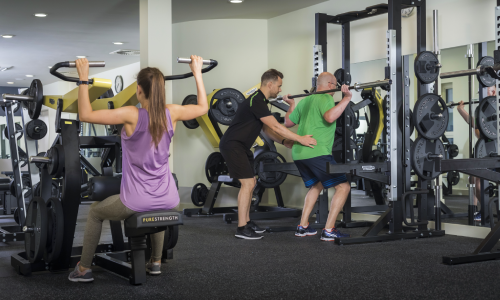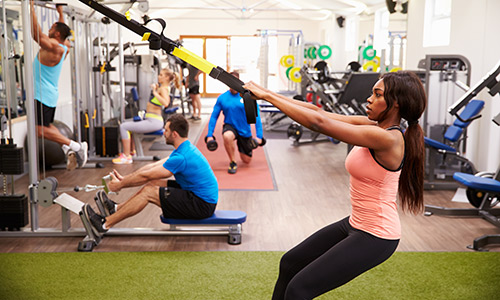What is resistance training? All you need to know before you start
- Overview
What is resistance training?
Resistance training is more commonly referred to by gymgoers as weight training. The truth is that the term refers to any form of exercise where you lift or pull against resistance.
Traditional resistance training uses dumbbells or a barbell to perform an exercise for a specific number of repetitions with the aim of improving muscular strength, size, or endurance.
Other popular forms of resistance training include gym machines, kettlebells, powerbands, bodyweight exercises, and repeating movements that work against any form of external resistance.
Are resistance and strength training the same?
Ideally, we need to call it ‘resistance training’, however it can be further split into three different categories. These are strength, hypertrophy, and endurance/conditioning. All three of these types of training focus on your muscles, but the weights, intensity and variations (such as reps/sets) all differ to create a specific training outcome for an individual.
What is functional strength training?
Functional strength training is a type of exercise that focuses on improving your ability to perform everyday activities and movements more efficiently and safely. The emphasis is on developing strength, flexibility, balance, and coordination that directly translates to real-life activities, whether you’re at home, work, or during recreational activities.
What is resistance training good for?

Lifting weights has numerous benefits for our muscles and skeleton that are unique to this form of training.
Resistance training improves your strength and can make everyday tasks easier to perform. This form of weight training can reduce the occurrence of sarcopenia, which is the age-related decline in muscle, and also decrease the risk of osteoporosis. Although all exercise can help with these, resistance training has been shown to be the most beneficial.
Regular resistance training can also decrease the risk of heart disease by lowering body fat, decreasing blood pressure, improving cholesterol levels, and lowering overall levels of stress placed on the heart.
Resistance training is the main way you will build and ‘tone up’ your muscles. It is by far the best way to alter your body composition and once you are at the point that you are lean enough to see your muscles, resistance training can give you the shape of arms, legs or bum that you desire.
Short term benefits
Although there is an emphasis on the long-term when talking about exercise, the short-term effects are just as important to keep us motivated.
There is a wealth of research on the relationship between our mental and physical health, with a well-established connection between movement and elevated mood. This occurs because our brain releases feel-good hormones called endorphins when we exercise.
Many people find that resistance training helps them relieve stress and improve their quality of sleep quality. Setting yourself challenging but attainable goals is also a great way to get a sense of accomplishment out of your workout routine.
Long term benefits
The long-term benefits of introducing resistance training into our routine are plentiful.
As we get older, our bodies respond differently because of the natural ageing process. Our muscle mass and bone density decrease, and because of reduced hormone production, we may feel tired and fatigued more regularly.
Resistance training helps strengthen our muscles and improve bone density in a safe and secure way as we train. This has a knock-on effect when it comes to mobility, fracture risks and the reduction of developing joint pain, which becomes more common as we age.
Find a style that works for you
Resistance training isn’t all about lifting heavy weights.
There are many different styles of resistance training that will have an overall benefit for your short and long-term health.
Unless you are training for a specific sport or goal, the type of resistance training you do can be tailored to what you enjoy. If you love lifting heavy weights and want to build muscle, you may want to opt for powerlifting movements.
Alternatively, if you prefer movements that focus on strengthening your deep, core muscles, Pilates and yoga can help condition your body and build functional strength that aids with day-to-day movement.
When should you do resistance training?
Everybody can benefit from some form of resistance training.
Whether you are an aspiring young athlete or someone who has never been in a gym before, resistance training has something for you. This style of training has unique health and fitness benefits that simply can't be achieved through any other form of exercise.
The ACSM (American College of Sports Medicine) recommends that a resistance training program should be performed a minimum of two non-consecutive days each week, with one set of 8 to 12 repetitions for healthy adults or 10 to 15 repetitions for older and frail individuals. Eight to 10 different exercises should be performed that target the major muscle groups.
Common misconceptions about resistance training
There are a lot of misconceptions and stereotypes surrounding resistance training. Below, we’ve listed some of the most common myths about resistance training to help you understand that this style of training is for everyone.
- I need to be strong
- I have to lift heavy weights
- Resistance training is just for young people
- Lifting weights is all about building muscle
- I have to train every day
- It’s all about aesthetics
- Lifting weights is just for men
- I’ll look bulky if I lift weights
- People who lift weights are more likely to get injured
Should women be doing resistance training?
Absolutely.

The benefits of resistance or strength training are in no way gender specific. Unfortunately, lifting weights and utilising certain areas in the gym is more uncommon in women than in men. Research indicates that just 28% of women believe resistance training should be part of their weekly workout routine.
The lack of women engaging with resistance training is partly due to the entrenched stereotypes around this form of exercise. Many women believe resistance training is “for men” or “all about building muscle” and so avoid it.
The reality is that resistance training has incredible benefits that can help reduce the impact of period pain and menopausal symptoms later in life.
The benefits for young women
Resistance training is important for women at any stage of their life. For teenage girls, resistance training can help to develop muscle strength, increase bone density, improve self-esteem, and reduce symptoms of anxiety and depression.
For young and pre-menopausal women, resistance training is a great way to work on building a solid foundation to set you up for later life. It is preventative and helps reduce your risk of developing conditions like osteoporosis and sarcopenia.
It’s sometimes helpful to think of resistance training as building a strong base that your body can benefit from later in life.
- Got young girls? Click here to learn more about getting them into exercise
Resistance training on your period
There is a common misconception that we shouldn’t train when we’re on our period. This isn’t the case.
The opposite is actually true – exercising on your period should be encouraged. This can include anything from resistance training to going for a walk. We know that exercising whilst on your period could help to reduce PMS symptoms and period pains.
Many women choose to adjust their training during the different stages of their cycle. Currently, there is no strong evidence to suggest we should do this. Instead, you should continue to meet your healthy exercise guidelines during each different stage of your menstrual cycle (follicular, ovulation, luteal, period).
If at certain points in your cycle, you feel low on energy or really don’t feel like working out, try swapping your hard session to another day to ensure you get the most out of it. The most important thing is that your body is moving in a way that feels good for you.
Last updated Wednesday 24 January 2024
First published on Monday 4 January 2016

